Changes in the Abundance and Taxonomic Composition of Benthic Heterotrophic Protists from Atlantic Sublittoral to Deep-Sea Sediments
Abstract
1. Introduction
2. Materials and Methods
2.1. Study Area and Sampling
2.2. Live-Counting
2.3. Cultivation Approach
2.4. Statistical Data Analyses
3. Results
3.1. Abundance and Biovolume of Nano-, Microfauna and Microphytobenthos
3.2. Total Abundance of Heterotrophic Protists
3.3. Relative Contribution of Taxonomic Groups to Total Heterotrophic Protist Abundance and Biovolume
3.4. Cultivable Protists
4. Discussion
5. Conclusions
Supplementary Materials
Author Contributions
Funding
Data Availability Statement
Acknowledgments
Conflicts of Interest
References
- Adl, S.M.; Bass, D.; Lane, C.E.; Lukeš, J.; Schoch, C.L.; Smirnov, A.; Agatha, S.; Berney, C.; Brown, M.W.; Burki, F.; et al. Revisions to the Classification, Nomenclature, and Diversity of Eukaryotes. J. Eukaryot. Microbiol. 2019, 66, 4–119. [Google Scholar] [CrossRef] [PubMed]
- Burki, F.; Roger, A.J.; Brown, M.W.; Simpson, A.G.B. The New Tree of Eukaryotes. Trends Ecol. Evol. 2020, 35, 43–55. [Google Scholar] [CrossRef] [PubMed]
- De Vargas, C.; Audic, S.; Henry, N.; Decelle, J.; Mahé, F.; Logares, R.; Lara, E.; Berney, C.; Le Boscot, N.; Probert, I.; et al. Eukaryotic Plankton Diversity in the Sunlit Ocean. Science 2015, 348, 1261605. [Google Scholar] [CrossRef] [PubMed]
- Azam, F.; Fenchel, T.; Field, J.G.; Gray, J.S.; Meyer-Reil, L.A.; Thingstad, F. The Ecological Role of Water-Column Microbes in the Sea. Mar. Ecol. Prog. Ser. 1983, 10, 257–263. [Google Scholar] [CrossRef]
- Worden, A.Z.; Follows, M.J.; Giovannoni, S.J.; Wilken, S.; Zimmerman, A.E.; Keeling, P.J. Rethinking the Marine Carbon Cycle: Factoring in the Multifarious Lifestyles of Microbes. Science 2015, 347, 1257594. [Google Scholar] [CrossRef]
- Caron, D.A.; Peele, E.R.; Lim, E.L.; Dennett, M.R. Picoplankton and Nanoplankton and Their Trophic Coupling in Surface Waters of the Sargasso Sea South of Bermuda. Limnol. Oceanogr. 1999, 44, 259–272. [Google Scholar] [CrossRef]
- Sanders, R.W.; Berninger, U.-G.; Lim, E.L.; Kemp, P.F.; Caron, D.A. Heterotrophic and Mixotrophic Nanoplankton Predation on Picoplankton in the Sargasso Sea and on Georges Bank. Mar. Ecol. Prog. Ser. 2000, 192, 103–118. [Google Scholar] [CrossRef]
- Sherr, E.B.; Sherr, B.F. Bacterivory and Herbivory: Key Roles of Phagotrophic Protists in Pelagic Food Webs. Microb. Ecol. 1994, 28, 223–235. [Google Scholar] [CrossRef]
- Gooday, A.J.; Schoenle, A.; Dolan, J.R.; Arndt, H. Protist Diversity and Function in the Dark Ocean—Challenging the Paradigms of Deep-Sea Ecology with Special Emphasis on Foraminiferans and Naked Protists. Eur. J. Protistol. 2020, 75, 125721. [Google Scholar] [CrossRef]
- Živaljić, S.; Schoenle, A.; Nitsche, F.; Hohlfeld, M.; Piechocki, J.; Reif, F.; Shumo, M.; Weiss, A.; Werner, J.; Witt, M.; et al. Survival of Marine Heterotrophic Flagellates Isolated from the Surface and the Deep Sea at High Hydrostatic Pressure: Literature Review and Own Experiments. Deep. Sea Res. Part II Top. Stud. Oceanogr. 2018, 148, 251–259. [Google Scholar] [CrossRef]
- Živaljić, S.; Scherwass, A.; Schoenle, A.; Hohlfeld, M.; Quintela-Alonso, P.; Nitsche, F.; Arndt, H. A Barotolerant Ciliate Isolated from the Abyssal Deep Sea of the North Atlantic: Euplotes Dominicanus sp. n. (Ciliophora, Euplotia). Eur. J. Protistol. 2020, 73, 125664. [Google Scholar] [CrossRef] [PubMed]
- Morgan-Smith, D.; Garrison, C.E.; Bochdansky, A.B. Mortality and Survival of Cultured Surface-Ocean Flagellates under Simulated Deep-Sea Conditions. J. Exp. Mar. Biol. Ecol. 2013, 445, 13–20. [Google Scholar] [CrossRef]
- Schoenle, A.; Hohlfeld, M.; Hermanns, K.; Mahé, F.; De Vargas, C.; Nitsche, F.; Arndt, H. High and Specific Diversity of Protists in the Deep-Sea Basins Dominated by Diplonemids, Kinetoplastids, Ciliates and Foraminiferans. Commun. Biol. 2021, 4. [Google Scholar] [CrossRef] [PubMed]
- Hohlfeld, M.; Schoenle, A.; Arndt, H. Horizontal and Vertical Small-Scale Patterns of Protist Communities at the Atlantic Deep-Sea Floor. Deep. Sea Res. Part I Oceanogr. Res. Pap. 2021, 171, 103515. [Google Scholar] [CrossRef]
- Pawlowski, J.; Christen, R.; Lecroq, B.; Bachar, D.; Shahbazkia, H.R.; Amaral-Zettler, L.; Guillou, L. Eukaryotic Richness in the Abyss: Insights from Pyrotag Sequencing. PLoS ONE 2011, 6, e18169. [Google Scholar] [CrossRef] [PubMed]
- Scheckenbach, F.; Hausmann, K.; Wylezich, C.; Weitere, M.; Arndt, H. Large-Scale Patterns in Biodiversity of Microbial Eukaryotes from the Abyssal Sea Floor. Proc. Natl. Acad. Sci. USA 2010, 107, 115–120. [Google Scholar] [CrossRef] [PubMed]
- Burki, F.; Sandin, M.M.; Jamy, M. Diversity and Ecology of Protists Revealed by Metabarcoding. Curr. Biol. 2021, 31, R1267–R1280. [Google Scholar] [CrossRef] [PubMed]
- Schoenle, A.; Jeuck, A.; Nitsche, F.; Venter, P.; Prausse, D.; Arndt, H. Methodological Studies on Estimates of Abundance and Diversity of Heterotrophic Flagellates from the Deep-Sea Floor. J. Mar. Sci. Eng. 2016, 4, 22. [Google Scholar] [CrossRef]
- Arndt, H.; Dietrich, D.; Auer, B.; Cleven, E.-J.; Gräfenhan, T.; Weitere, M.; Mylnikov, A.P. Functional Diversity of Heterotrophic Flagellates in Aquatic Ecosystems. In The Flagellates; Leadbeater, B.S.C., Green, J.C., Eds.; Taylor & Francis Ltd.: London, UK, 2000; pp. 240–268. [Google Scholar]
- Arndt, H.; Hausmann, K.; Wolf, M. Deep-Sea Heterotrophic Nanoflagellates of the Eastern Mediterranean Sea: Qualitative and Quantitative Aspects of Their Pelagic and Benthic Occurrence. Mar. Ecol. Prog. Ser. 2003, 256, 45–56. [Google Scholar] [CrossRef]
- Bak, R.P.M.; Nieuwland, G. Seasonal Variation in Bacterial and Flagellate Communities of Deep-Sea Sediments in a Monsoonal Upwelling System. Deep. Sea Res. Part II 1997, 44, 1281–1292. [Google Scholar] [CrossRef]
- Burnett, B.R. Quantitative Sampling of Nanobiota (Microbiota) of the Deep-Sea Benthos—III. The Bathyal San Diego Trough. Deep. Sea Res. Part A Oceanogr. Res. Pap. 1981, 28, 649–663. [Google Scholar] [CrossRef]
- Danovaro, R.; Marrale, D.; Della Croce, N.; Dell’Anno, A.; Fabiano, M. Heterotrophic Nanoflagellates, Bacteria, and Labile Organic Compounds in Continental Shelf and Deep-Sea Sediments of the Eastern Mediterranean. Microb. Ecol. 1998, 35, 244–255. [Google Scholar] [CrossRef]
- Alongi, D.M. The Distribution and Composition of Deep-Sea Microbenthos in a Bathyal Region of the Western Coral Sea. Deep. Sea Res. Part A Oceanogr. Res. Pap. 1987, 34, 1245–1254. [Google Scholar] [CrossRef]
- Salani, F.S.; Arndt, H.; Hausmann, K.; Nitsche, F.; Scheckenbach, F. Analysis of the Community Structure of Abyssal Kinetoplastids Revealed Similar Communities at Larger Spatial Scales. ISME J. 2012, 6, 713–723. [Google Scholar] [CrossRef] [PubMed]
- George, K.; Arndt, H.; Wehrmann, A.; Baptista, L.; Berning, B.; Bruhn, M.; Carvalho, F.; Cordeiro, R.; Creemers, M.; Defise, A.; et al. Controls in Benthic and Pelagic Biodiversity of the Azores Biodiaz; METEOR-Berichte: Senckenberg am Meer, Germany, 2018. [Google Scholar]
- Schlitzer, R. Ocean Data View; Alfred Wegener Institute for Polar and Marine Research: Bremerhaven, Germany, 2015. [Google Scholar]
- R Core Team. R: A Language and Environment for Statistical Computing; R Foundation for Statistical Computing: Vienna, Austria, 2021. [Google Scholar]
- Orksanen, J.; Blanchet, F.G.; Friendly, M.; Kindt, R.; Legendre, P.; McGlinn, D.; Minchin, P.R.; O’Hara, R.B.; Simpson, G.L.; Solymos, P.; et al. Vegan: Community Ecology Package. R Package Version 2.5-2 2018. Available online: https://github.com/vegandevs/vegan (accessed on 1 February 2022).
- Suzuki, R.; Shimodaira, H. Pvclust: An R Package for Assessing the Uncertainty in Hierarchical Clustering. Bioinformatics 2006, 22, 1540–1542. [Google Scholar] [CrossRef]
- Wickham, H. Ggplot2: Elegant Graphics for Data Analysis; Springer: Houston, Texas, USA, 2009. [Google Scholar]
- Alongi, D.M. Bathymetric Patterns of Deep-Sea Benthic Communities from Bathyal to Abyssal Depths in the Western South Pacific (Solomon and Coral Seas). Deep. Sea Res. Part A Oceanogr. Res. Pap. 1992, 39, 549–565. [Google Scholar] [CrossRef]
- Mukherjee, I.; Hodoki, Y.; Nakano, S. Kinetoplastid Flagellates Overlooked by Universal Primers Dominate in the Oxygenated Hypolimnion of Lake Biwa, Japan. FEMS Microbiol. Ecol. 2015, 91, fiv083. [Google Scholar] [CrossRef] [PubMed]
- Dietrich, D.; Arndt, H. Biomass Partitioning of Benthic Microbes in a Baltic Inlet: Relationships between Bacteria, Algae, Heterotrophic Flagellates and Ciliates. Mar. Biol. 2000, 136, 309–322. [Google Scholar] [CrossRef]
- Flegontova, O.; Flegontov, P.; Londoño, P.A.C.; Walczowski, W.; Šantić, D.; Edgcomb, V.P.; Lukeš, J.; Horák, A. Environmental Determinants of the Distribution of Planktonic Diplonemids and Kinetoplastids in the Oceans. Environ. Microbiol. 2020, 22, 4014–4031. [Google Scholar] [CrossRef]
- Kudryavtsev, A.; Pawlowski, J.; Smirnov, A. More Amoebae from the Deep-Sea: Two New Marine Species of Vexillifera (Amoebozoa, Dactylopodida) with Notes on Taxonomy of the Genus. Eur. J. Protistol. 2018, 66, 9–25. [Google Scholar] [CrossRef]
- Grossart, H.; Gust, G. Hydrostatic Pressure Affects Physiology and Community Structure of Marine Bacteria during Settling to 4000 m: An Experimental Approach. Mar. Ecol. Prog. Ser. 2009, 390, 97–104. [Google Scholar] [CrossRef]
- Atkins, M.S.; Anderson, O.R.; Wirsen, C.O. Effect of Hydrostatic Pressure on the Growth Rates and Encystment of Flagellated Protozoa Isolated from a Deep-Sea Hydrothermal Vent and a Deep Shelf Region. Mar. Ecol. Prog. Ser. 1998, 171, 85–95. [Google Scholar] [CrossRef]
- Schoenle, A.; Nitsche, F.; Werner, J.; Arndt, H. Deep-Sea Ciliates: Recorded Diversity and Experimental Studies on Pressure Tolerance. Deep. Sea Res. Part I Oceanogr. Res. Pap. 2017, 128, 55–66. [Google Scholar] [CrossRef]
- Živaljić, S.; Schoenle, A.; Scherwass, A.; Hohlfeld, M.; Nitsche, F.; Arndt, H. Influence of Hydrostatic Pressure on the Behaviour of Three Ciliate Species Isolated from the Deep-Sea Floor. Mar. Biol. 2020, 167, 63. [Google Scholar] [CrossRef]
- Hellebust, J.A.; Lewin, J. Heterotrophic Nutrition. In The Biology of Diatoms; Werner, D., Ed.; University of California Press: Berkeley and Los Angeles, CA, USA, 1977; pp. 169–197. [Google Scholar]
- Flegontova, O.; Flegontov, P.; Malviya, S.; Audic, S.; Wincker, P.; de Vargas, C.; Bowler, C.; Lukeš, J.; Horák, A. Extreme Diversity of Diplonemid Eukaryotes in the Ocean. Curr. Biol. 2016, 26, 3060–3065. [Google Scholar] [CrossRef] [PubMed]
- Lara, E.; Moreira, D.; Vereshchaka, A.; López-García, P. Pan-Oceanic Distribution of New Highly Diverse Clades of Deep-Sea Diplonemids. Environ. Microbiol. 2009, 11, 47–55. [Google Scholar] [CrossRef]
- Lukeš, J.; Flegontova, O.; Horák, A. Diplonemids. Curr. Biol. 2015, 25, R702–R704. [Google Scholar] [CrossRef][Green Version]
- Sime-Ngando, T.; Juniper, K.; Vézina, A. Ciliated Protozoan Communities over Cobb Seamount: Increase in Biomass and Spatial Patchiness. Mar. Ecol. Prog. Ser. 1992, 89, 37–51. [Google Scholar] [CrossRef]
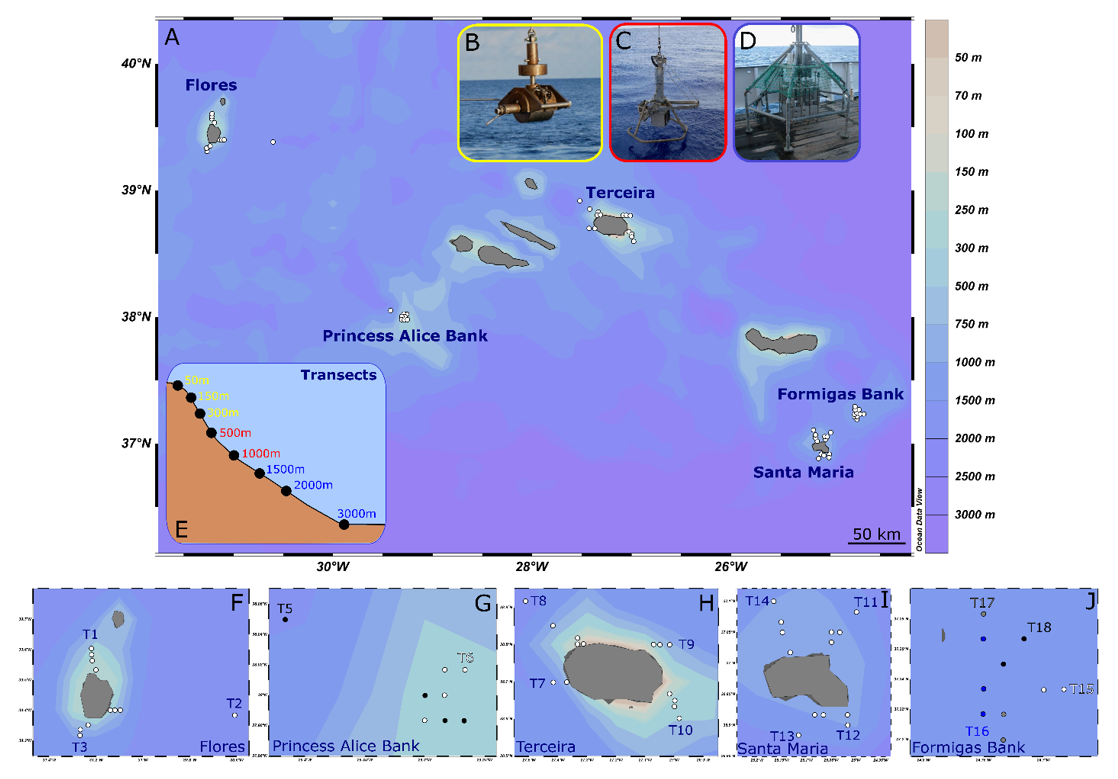
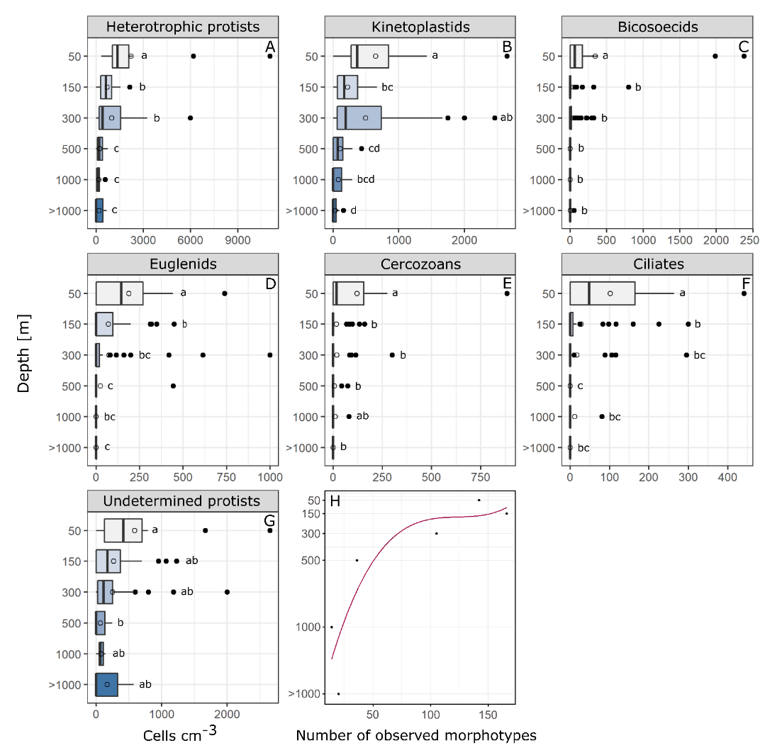
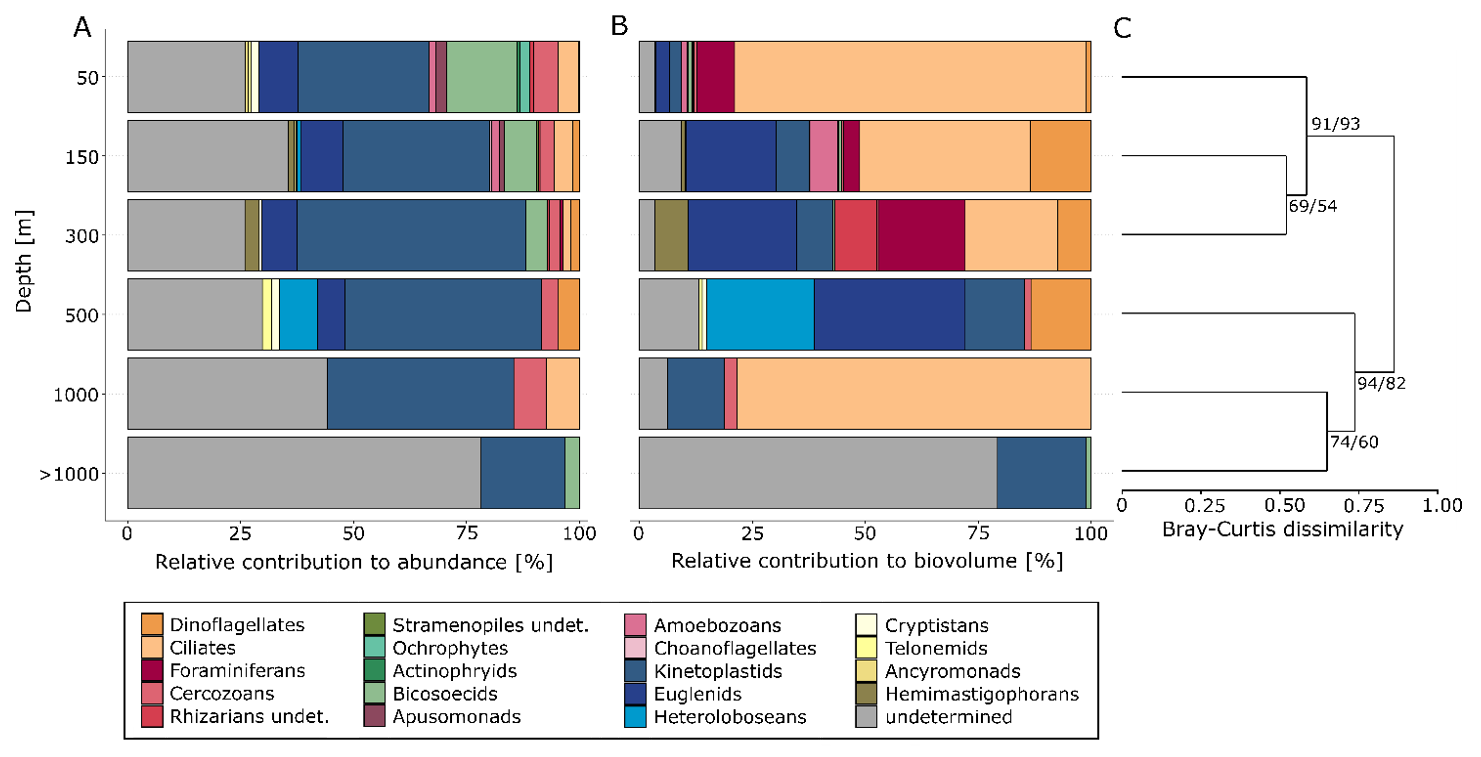
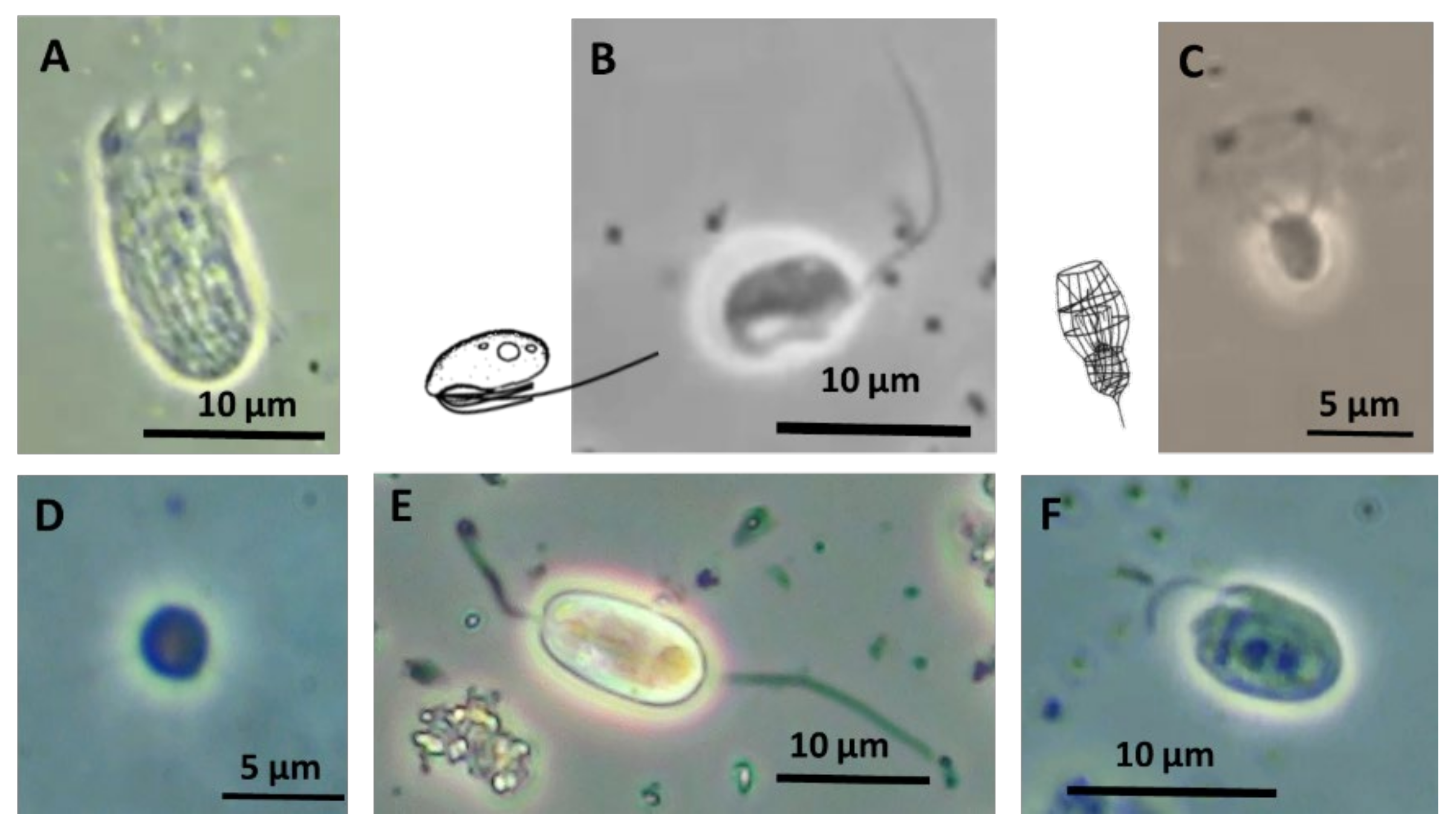
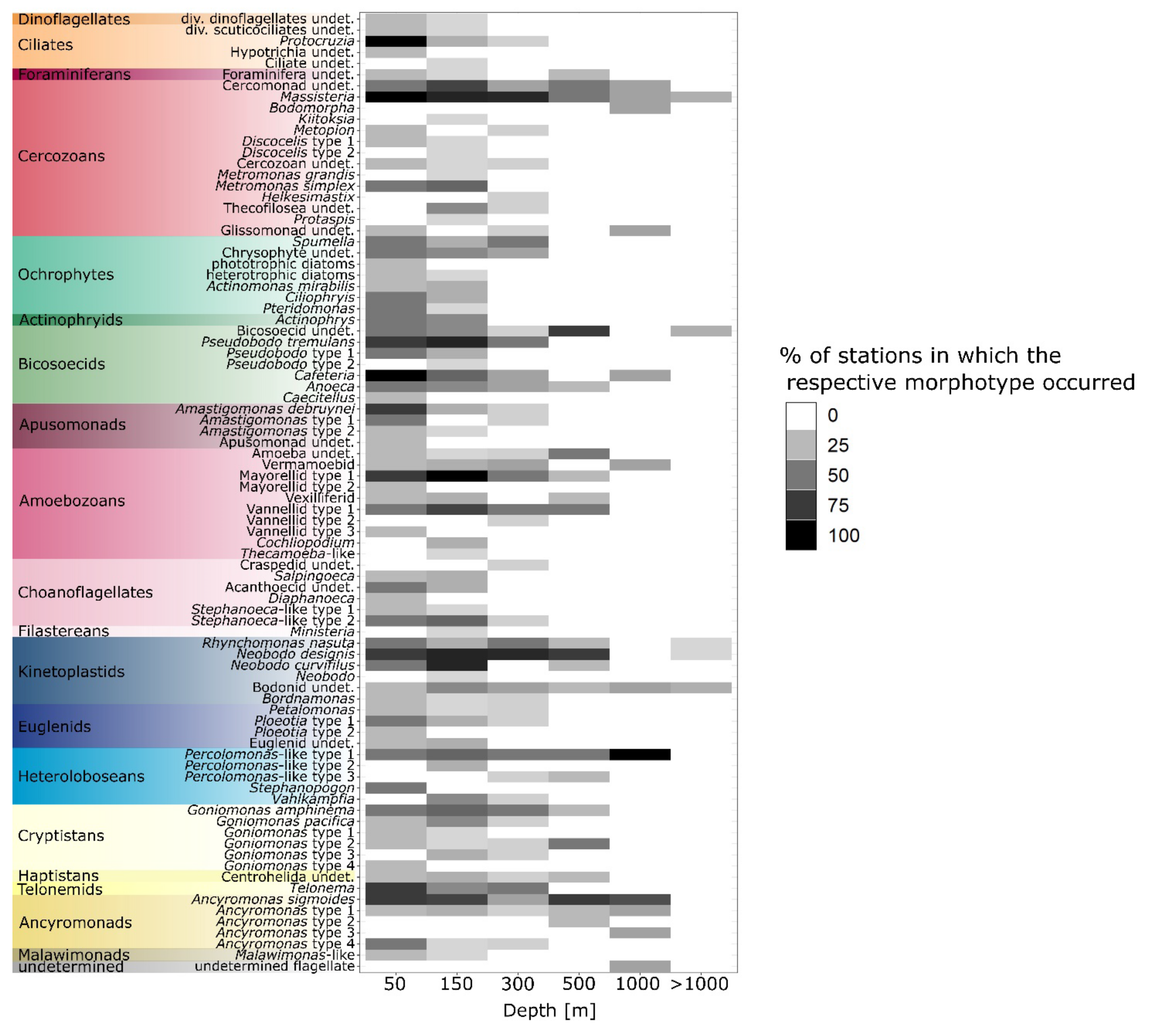
| 50 m | 150 m | 300 m | 500 m | 1000 m | 1500–3000 m | |
|---|---|---|---|---|---|---|
| Abundance [cells cm−3] | ||||||
| Nanofauna | 2088 (320–10,600) | 637 (0–1840) | 946 (0–6000) | 215 (0–750) | 201 (0–520) | 207 (0–674) |
| Microfauna | 126 (0–442) | 64 (0–307) | 41 (0–420) | 31 (0–444) | 23 (0–161) | 0 |
| Microphytobenthos | 915 (0–8392) | 43 (0–321) | 15 (0–444) | 0 | 0 | 0 |
| Biovolume [µm3 cm−3] | ||||||
| Nanofauna | 159,200 (18,900–589,200) | 43,210 (0–236,200) | 72,800 (0–891,200) | 16,910 (0–99,750) | 6400 (0–30,800) | 6900 (0–29,600) |
| Microfauna | 998,300 (0–7,749,000) | 124,200 (0–706,900) | 210,200 (0–2,304,000) | 38,040 (0–465,400) | 21,720 (0–152,000) | 0 |
| Microphytobenthos (only pennate diatoms) | 612,400 (0–3,254,000) | 32,100 (0–558,200) | 18,100 (0–580,900) | 0 | 0 | 0 |
Publisher’s Note: MDPI stays neutral with regard to jurisdictional claims in published maps and institutional affiliations. |
© 2022 by the authors. Licensee MDPI, Basel, Switzerland. This article is an open access article distributed under the terms and conditions of the Creative Commons Attribution (CC BY) license (https://creativecommons.org/licenses/by/4.0/).
Share and Cite
Hohlfeld, M.; Arndt, H. Changes in the Abundance and Taxonomic Composition of Benthic Heterotrophic Protists from Atlantic Sublittoral to Deep-Sea Sediments. Diversity 2022, 14, 164. https://doi.org/10.3390/d14030164
Hohlfeld M, Arndt H. Changes in the Abundance and Taxonomic Composition of Benthic Heterotrophic Protists from Atlantic Sublittoral to Deep-Sea Sediments. Diversity. 2022; 14(3):164. https://doi.org/10.3390/d14030164
Chicago/Turabian StyleHohlfeld, Manon, and Hartmut Arndt. 2022. "Changes in the Abundance and Taxonomic Composition of Benthic Heterotrophic Protists from Atlantic Sublittoral to Deep-Sea Sediments" Diversity 14, no. 3: 164. https://doi.org/10.3390/d14030164
APA StyleHohlfeld, M., & Arndt, H. (2022). Changes in the Abundance and Taxonomic Composition of Benthic Heterotrophic Protists from Atlantic Sublittoral to Deep-Sea Sediments. Diversity, 14(3), 164. https://doi.org/10.3390/d14030164







